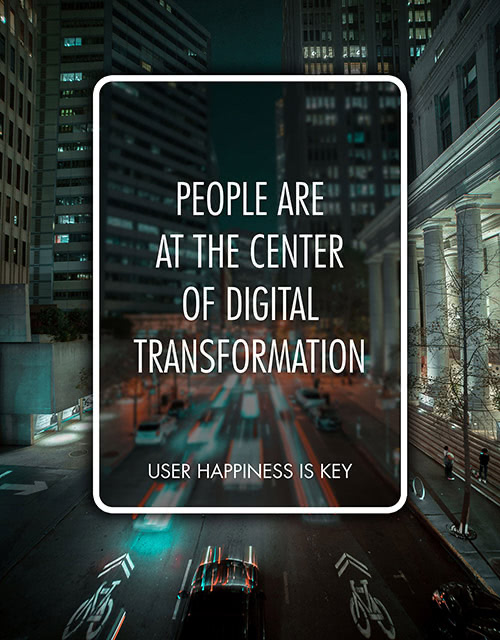
User Happiness Can Make or Break Your Digital Transformation Project
The expression “Digital Transformation” sounds like it’s all about technology, but it’s not.
It’s about people.
People — users — are ultimately the reason for and the recipients of digital change, which can impact them for better or worse. For example, while online shoppers might rejoice at a more improved and streamlined retail experience, warehouse workers might find a new inventory system disruptive and frustrating, tethering them to computer screens more tightly than before.
I’m by no means the first to put people at the center of digital transformation, but many businesses have yet to fully embrace the importance of user experience (UX). Automation needs to be well crafted to enable efficiency and usability. If businesses prioritize the importance of the user experience, encompassing a broad picture of impacts that automation might have on customers and employees, then we UX professionals can partner with them in developing successful strategies to create positive outcomes.
Strategy and Leadership are Key
For many businesses, the pandemic has created a tipping point for digital transformation. According to a McKinsey Co. report, in just a few months’ time, the COVID-19 crisis has brought about years of change in the way companies in all sectors and regions do business.
When business leaders were asked what led to this Covid-19-accelerated transformation, they cited “changing customer needs and expectations” as main drivers. We can imagine this encompasses everything from the choice to do more shopping online to the desire to avoid face-to-face encounters with service professionals such as medical providers to the need to work from home.
Conversely, when business leaders were asked why digital transformation lagged pre-pandemic, “employee resistance to change” was frequently cited. This should come as little surprise. Employees tend to fear and resist change — assuming it will threaten their job security or force them to work in different ways that they may not like.
Sadly, in the same McKinsey Co. survey, business leaders acknowledged that only a small percentage of the technology upgrades they’ve made have resulted in increased sales or a more robust bottom line.
In other words, only a small percentage of digital transformation initiatives were deemed successful!
So what’s the problem? Respondents predictably pointed to lack of strategy and leadership within an organization. But more interesting is that they also suggested that companies have not done a great job paying enough attention to how employees and customers would be impacted by the changes.
Are Your Changes Driving Transformation or Stalling it?
Creating digital change in a way that works for people is the key to its success. Therefore ensuring that employees and customers benefit from — or at the least, are not negatively impacted by — digital transformation is of utmost importance.
As UX researchers and designers involved in digital transformation projects, we have an opportunity — a responsibility — to contribute to the success of these projects by making sure we are looking at the big picture. Our research focus should include the potential impact digital transformation projects could have on users as opposed to only what we in the UX community typically do: confine our questions to those specifically related to the new interface we may be designing.
Doing so limits our effectiveness as designers, and can ultimately hamper the success of the initiative. Instead, we need to take a broader view and consider the big picture before we even start designing solutions.
UX Research and Design Can Propel Success
We not only care about the quality of any software or device that we design, but also about the impact it may have on the employees who are tasked with using it. If employees are resistant or fearful of it we can mitigate that through various means, including suggesting different design solutions, providing training sessions and raising questions with stakeholders about the impacts of potential change.
It’s true that identifying the right questions to ask can be a challenge. And even when you know what to ask, getting insightful responses may be onerous since users themselves may have a difficult time predicting how their company’s particular flavor of digital transformation might impact them.
To help you gain more insight into potential impacts of an automation project, here are a few questions to get users thinking critically. Notice that most of these questions inquire either about how users currently work or how they foresee the new UI/product/process might impact their work.
- How do you currently do your work? Describe the processes and tools you use.
- Will this new software/device change how you do your work? How?
- Do you think that this change to a new software/device will be an improvement in your work processes? Can you provide details whether yes or no?
- What are your concerns about this new software/device? Learnability? Efficiency? Other?
- Do you have suggestions for what digital capabilities might make your work better, more efficient and pleasant?
- How do you think this new software/device will impact your coworkers and how you collaborate with them?
The Takeaway
By definition, digital transformation is about improvements to existing systems and processes for the benefit of users and stakeholders. Sure, not all digital updates affect users directly in the context of an interface. Many are infrastructure-related and simply allow a business to gather better data, increase performance or enhance security.
Still, these changes often trickle down in some way to affect users. And many automation updates affect users directly in the interfaces they must interact with, as well as in the work processes they use, and possibly in the actual tasks they perform.
To ensure the success of digital transformation projects, organizations should thoroughly analyze the impacts — direct and indirect — of these changes on employees and customers. As UX professionals, we can partner with businesses to ensure success. That means doing user research and applying that knowledge as we craft UX strategies and design new solutions that provide the most benefits and least downside to users and stakeholders.
